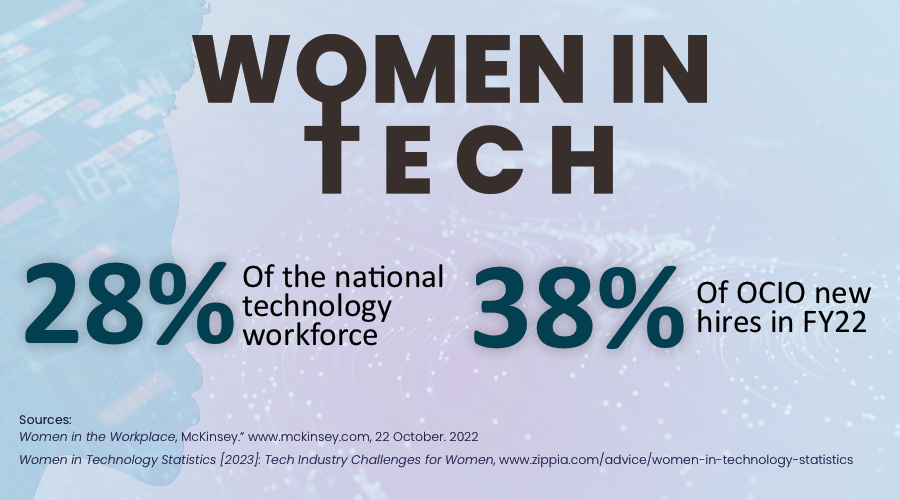
March is Women’s History Month, and an opportunity to reflect on the work we must all do to promote gender equality across the workforce, and especially in careers where women have been historically underrepresented, like technology. From Ada Lovelace, “the first computer programmer,” to Grace Hopper, who created one of the first programming languages, to Annie Easley, known for her work on NASA’s Centaur project, women have played an enormous role in the history of technology. But women are still underrepresented in tech, making up only 28% of the tech industry workforce in 2022.
The Office of the Chief Information Officer within the Department of Labor is an information technology-based organization seeking to promote excellence and equality in technology by incorporating the unique perspectives, skills and voices of women in leadership roles. We seek to help close the gender gap within tech career paths. For example, in fiscal year 2022, 38% of our new hires were women.

We seek to advance representation among women in the tech field and ensure that their career opportunities are equitable, sustainable and desirable. The women employed within OCIO are an integral part of our team, and we could not achieve our vision of excellence without their expertise and the knowledge they share each day.
In honor of the women of OCIO and their contributions to the Department of Labor’s mission, we asked some of the impressive women leading OCIO into the future to share their thoughts on women in tech:
Julie DeNiro, chief of enterprise architecture: “Technology has been something that I’ve always enjoyed and loved. I have come up the ranks from being hands-on with system administration to program management, then to portfolio management. Everything along the way has just kept me engaged.”
Anne Klieve, data project lead within OCIO’s Data Analytics Center of Excellence: “Women in leadership roles have inspired me because I see myself in them, and I am grateful to have them as examples. It’s really empowering to work in a department like DOL where we have a number of senior leadership positions filled by women. I seek to one day become them, and I see examples that I can use as templates as I think about the type of leader I want to be. That has been powerful.”
Kris Mena, branch chief for relationship management: “I think as a woman coming into a male-dominated field you have to decide how you’re going to present yourself. You could try to be one of the guys. You can come in and try to adopt a male perspective on how to talk to people or lead projects, but what works best is just being who you are. Fortunately, I’m older now, so I have a pretty good idea of what I’m capable of, what my skill sets are. So, when I come into a new team, whether it’s all men, or a mix of men and women, I’m coming into it knowing who I am and what I bring to that team.”
Sharon Kelser, director, security authorization management: “I would tell any young woman to go where their passion lies. If it is in the technology field, don’t let that ever-changing, fast-paced nature scare you. Instead, let that be a motivator. There is so much to do and so many areas to learn in IT.”
The women of OCIO personify both the history and future of technology. Their stories show the progress that has been made and the work that must still be done. Technology, like any other industry, advances when more perspectives, backgrounds and experiences are brought to the table. At OCIO, we ensure the opportunities we offer are accessible to all. Technology is open to everyone, and we invite you to join us.
Meet more of the amazing women of OCIO in our video, Women in Tech:
Wendy Manning is the director of administration for the Office of the Chief Information Officer. Follow OCIO on Twitter and LinkedIn.
Editor's note: This blog post was originally published in March 2022 and was updated in March 2023 with the latest statistics available.

 U.S. Department of Labor Blog
U.S. Department of Labor Blog